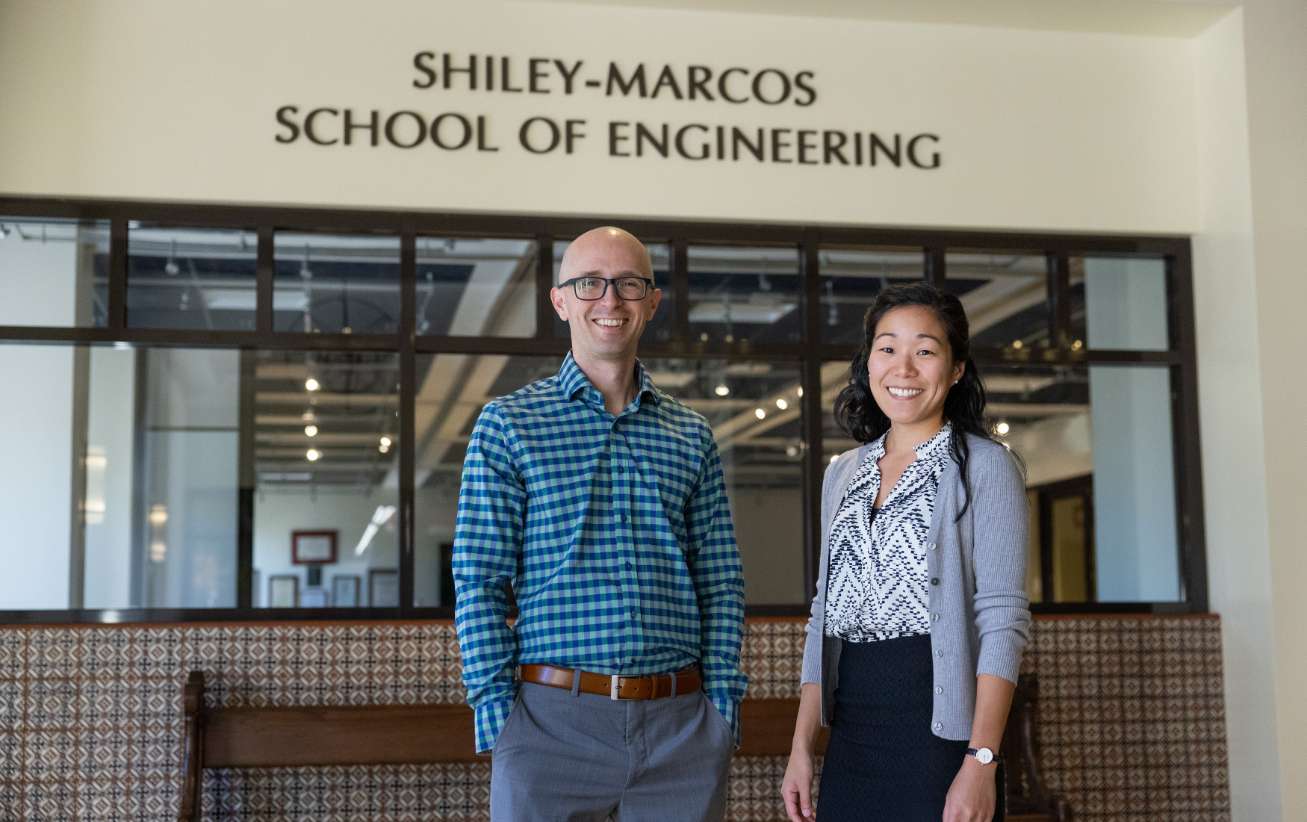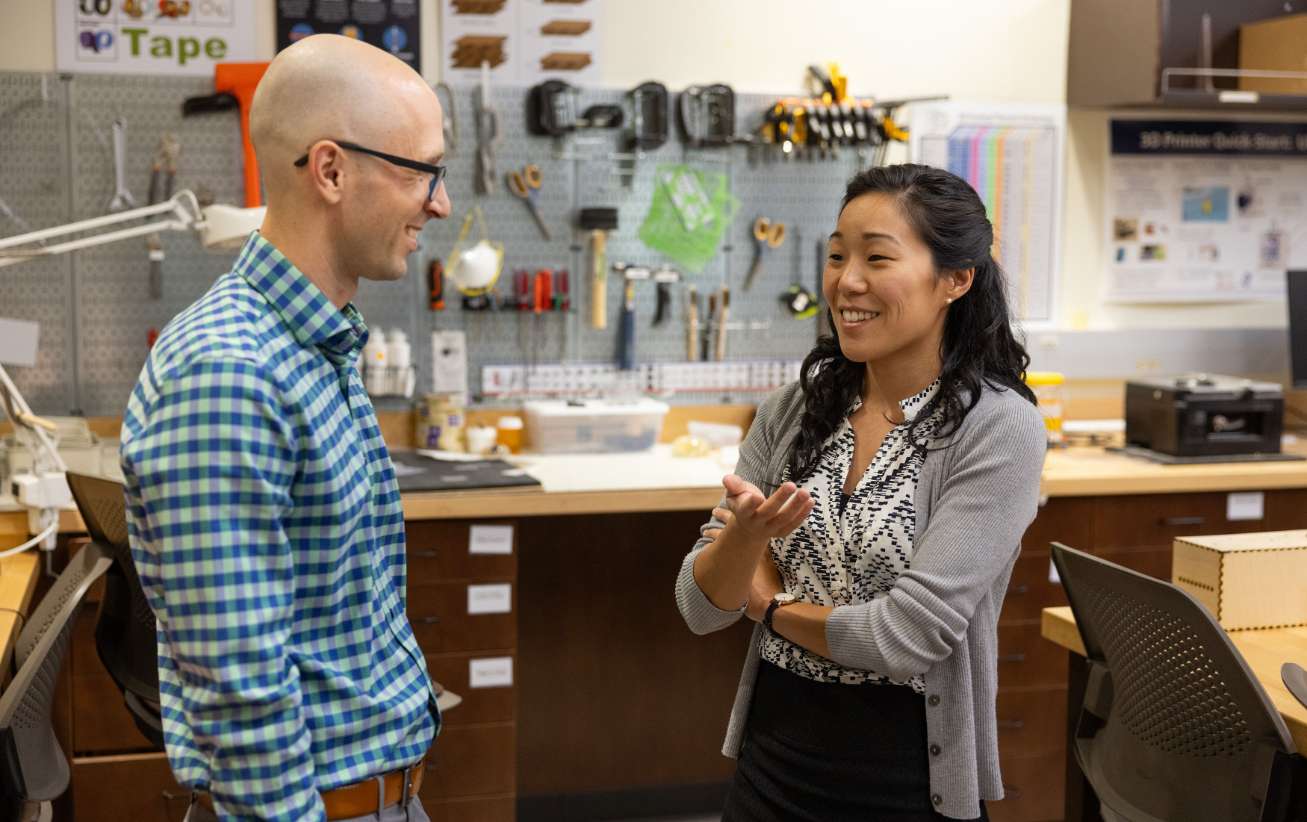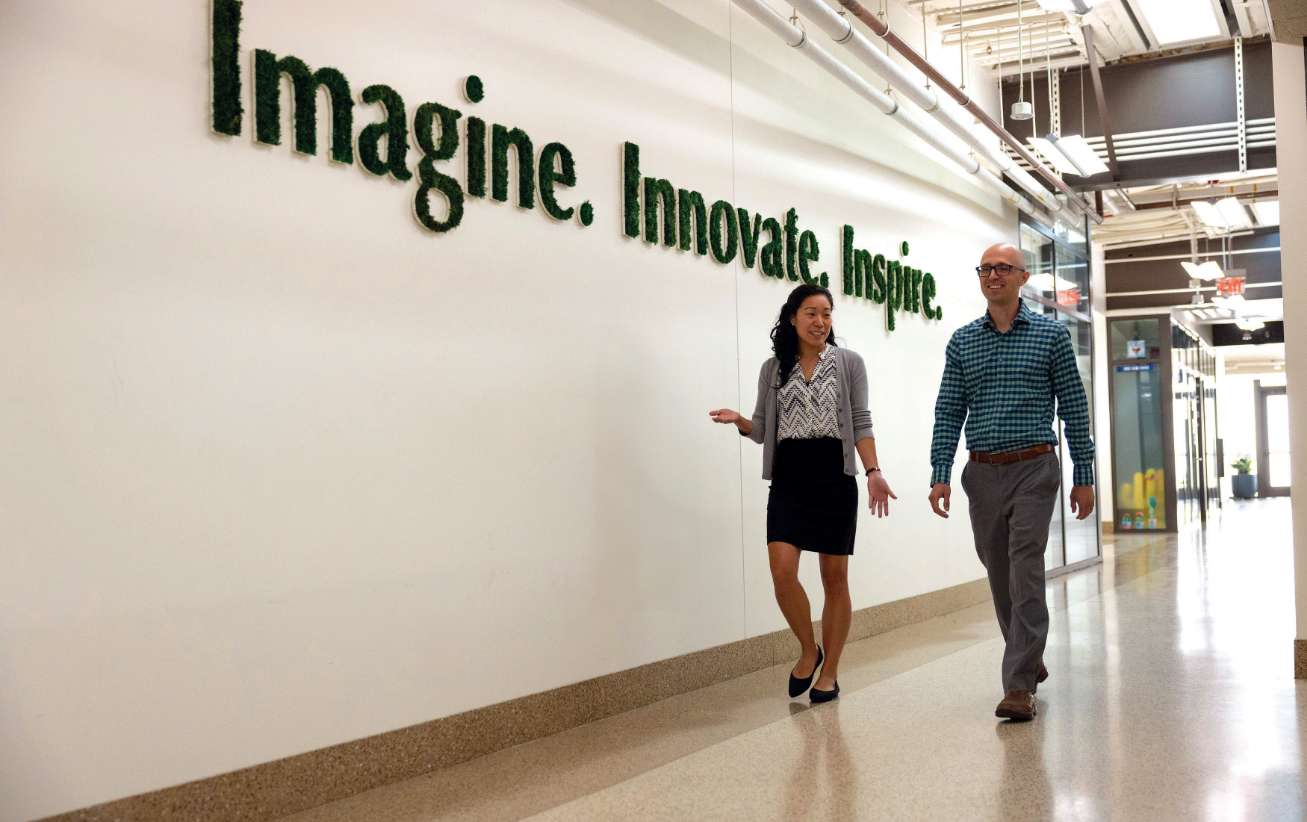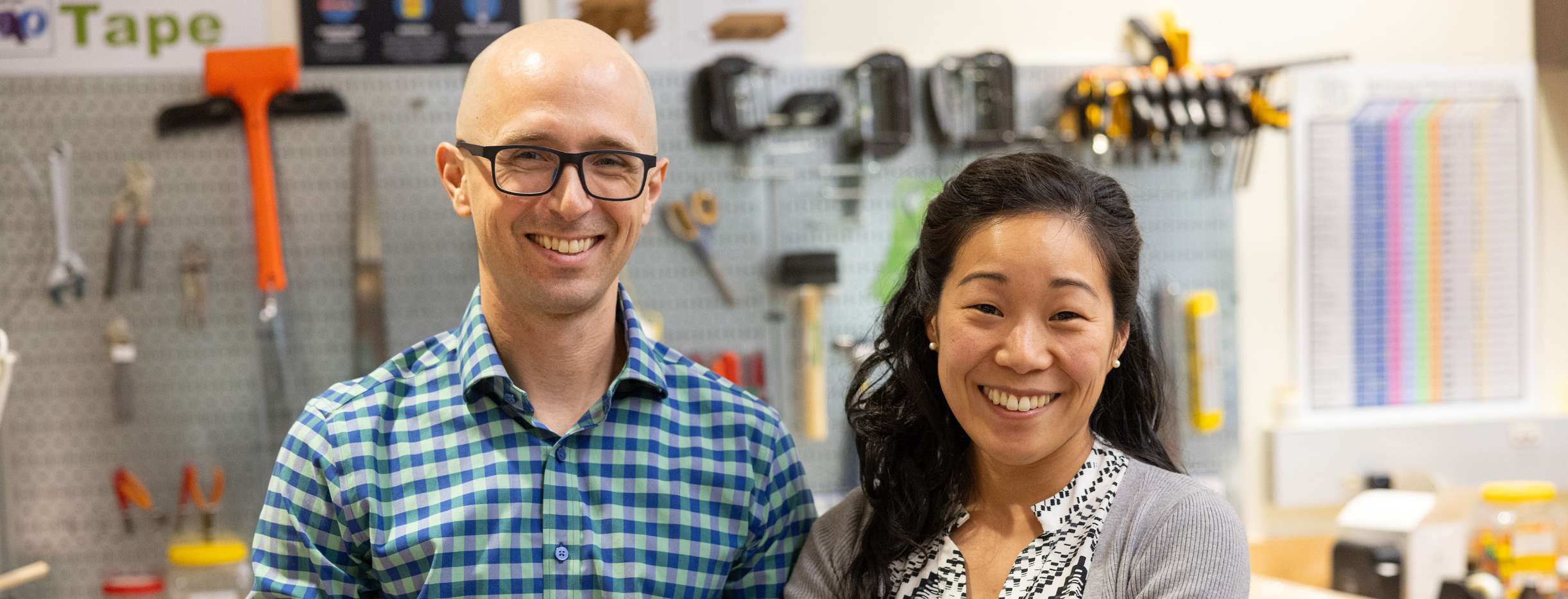Engineering and Socio-Technical Thinking
Two alumni, now engineering faculty at University of San Diego, built the foundation of a new department informed by their Harvey Mudd experience.
Although they didn’t overlap as students at Harvey Mudd, alumni Diana Chen ’13 and Gordon Hoople ’08 are now close colleagues—and friends—as associate professors of engineering at University of San Diego (USD). Together, shortly after they joined USD in 2016, Chen and Hoople helped establish a new department at USD’s Shiley-Marcos School of Engineering, one that underscores the intersection of engineering, the humanities and societal impact.
Both Chen and Hoople emphasize how crucial it is for budding engineers to understand that the field is inherently socio-technical, and that teaching engineering requires a holistic approach. They officially launched USD’s new Department of Integrated Engineering in fall 2017.
As part of this endeavor, they also aim, through their own collaborative research, to increase inclusivity in a field that has historically lacked improvement and advancement in diversity, equity and inclusion.
For six years and counting, the Integrated Engineering department has grown from eight students to now being at full capacity (55 students) in all of the department’s course offerings. Students in the program select from four concentration areas—biomedical engineering, embedded software, sustainability, and engineering and the law—or they work with a faculty member to create an independent plan of study as a concentration.
Chen and Hoople discuss the new engineering curriculum they are co-designing at USD and their viewpoints on incorporating socio-technical thinking into today’s engineering classroom.
How did you both get involved in starting the new Department of Integrated Engineering at University of San Diego?
Hoople: The dean and the department chair knew that they wanted to start a holistic engineering program, something I recognized as very similar to Harvey Mudd. The reason we were hired in large part is because of our background at Harvey Mudd—the background in the general engineering degree and the breadth of focus there. That all really was very clear in both of our applications and in both of our interviews.

Diana Chen ’13 and Gordon Hoople ’08 helped establish a new department at University of San Diego’s Shiley-Marcos School of Engineering, one that underscores the intersection of engineering, the humanities and societal impact.
As an undergraduate, what attracted you to Harvey Mudd and how has the HMC curriculum informed the work that you’re doing now at USD?
Chen: Harvey Mudd’s mission—the idea of caring about impact on society—and the fact that the humanities is built into the curriculum is what I really liked about its engineering program. My humanities courses were my favorite classes. Gordon and I have a shared history of caring about the Harvey Mudd mission but then graduating and not knowing what to do with it. Our humanities and our engineering education at Mudd were so separate. We’ve taken that and we’re integrating the humanities and engineering a bit more in the program that we have at USD.
Hoople: The Clinic Program is what really drew me to Harvey Mudd, and the breadth of the degree because it wasn’t narrowly tracked and specifically focused. Interestingly now I’m very involved in our equivalent of the Clinic Program at the University of San Diego. I’ve done a lot of work with that program and made it more interdisciplinary and have brought teams together across not only our department in integrated engineering but also the electrical engineering and the mechanical engineering departments.
What makes this new department so unique?
Hoople: Our program was explicitly set out with this foundation of bringing social and technical together. We already had a mechanical engineering department. We already had an electrical engineering department. We really wanted to bring in USD’s mission, which is all about our Catholic intellectual tradition and social justice, into the engineering classroom and think about how engineers impact society and how we can actually make the world a better place because, too often, engineering is completely devoid of that societal context.

How is that being incorporated into the classroom?
Chen: What stands out the most about our program is that we have two required courses in how social justice and engineering intersect. At the lower level, I’ve designed a User-Centered Design course that explores diversity, privilege and oppression, and how engineers really should be thinking about how our designs impact people and society. At the upper division, Integrated Engineering students take a deeper dive into analyzing unequal power relationships within engineering as a practice and critiquing historical and sociopolitical factors that affect who is included in engineering.
Hoople: We have an energy course that we’ve developed through an NSF grant award that explicitly is looking at how do we draw from a collection of teaching techniques, called culturally sustaining pedagogies, to create a more inclusive environment in the classroom, and we did it in the context of energy.
This brand-new course puts things like renewable energy at the forefront of the course rather than talking about fossil fuel-based energy supplies, which is often done in a mechanical engineering thermodynamics course, for example. We set out to change the ways we talk about engineering problems, for example, by having more people-forward examples and including a more diverse set of viewpoints. Part of the class is a discussion on sustainability. Not only do we look at the definition of sustainability from the 1970s that came out of the UN, but we are also looking even further back to indigenous conceptions of sustainability and try to understand how those can help us as we search for more sustainable approaches to engineering.
What current research dovetails with your work in curriculum design?
Chen: We are working together on a racial equity project, which I am the primary investigator of, that’s examining “whiteness” in engineering culture. Why is the default to consider women and Black, Indigenous and other people of color (BIPOC) to be “underrepresented” in engineering, instead of questioning why White men are “overrepresented” in engineering, when there are twice as many White men in the engineering workforce than there are in the general population? Our project asks, “what about our culture is causing engineering to be an exclusionary space?” Our last grant together, which Gordon was the PI of, explored the use of inclusive pedagogies in our engineering courses in order to broaden participation and make engineering a more racially equitable space. Our current grant builds on that and our goal now is to target faculty. Faculty are often the gatekeepers of engineering culture, and we are at the frontlines as mentors and authorities of engineering curricula. If we can help engineering faculty across the nation to develop a critical consciousness, our hope is that these faculty will become change agents, influencing their students, their colleagues and the very fabric of their institutions’ cultures to begin to dismantle forces of systemic oppression in engineering higher education.
“We really wanted to bring in USD’s mission, which is all about our Catholic intellectual tradition and social justice, into the engineering classroom and think about how engineers impact society and how we can actually make the world a better place because, too often, engineering is completely devoid of that societal context.”GORDON HOOPLE ’08

What exactly is meant by socio-technical engineering, and why is it important in today’s classroom?
Hoople: There was a great paper from a few years ago that included interviews with engineers at various stages in their careers. If you talk to an engineer who has just graduated from school, they say, “I wish I had taken one more technical elective related to the job I’m doing right now.” You talk to them 10 years later, they go, “You know, I wish I had taken one more business course because now I’m more of a manager,” and you talk to them 10 years after that, they say, “I should have taken more humanities classes while I was in college because I see now that engineering is really just about people and about how they work together.” So, engineering at its heart is not about being able to do math. That’s one of the tools that’s in our toolbox. It’s about being able to work with people and come up with solutions that serve society, and that’s what we need to be teaching our students.
Chen: What both of us really appreciate from our time at Mudd is that we learned how to learn; that was something Mudd was very good at. We’ve taken that and packaged it in our mission statement as a department. We want to teach students to be able to use and find resources. Our goal is that they can go into any discipline after they graduate from our program. They can be engineers, they can be lawyers, they can be doctors, whatever they want to be, but they know how to problem solve and think like an engineer, while still critically evaluating their own impact on society.
